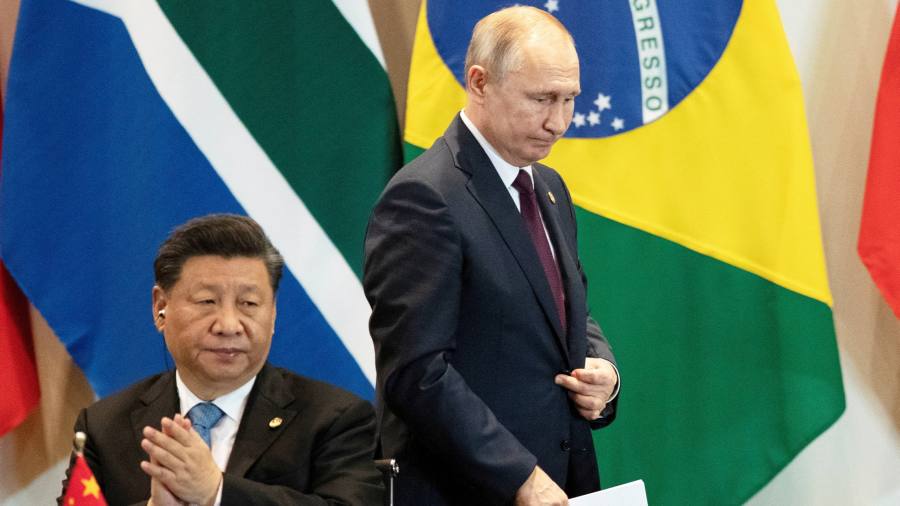The writer is an investment director at GAM
The dollar rise over the past year has inspired a lot of hopeful thinking in emerging markets about reducing their dependence on the currency and sensitivity to the tides of US rates.
The Federal Reserve hiking cycle of 2022 emphasised how tightly international monetary conditions are linked to those in the US, while the robust sanctions-led US response to the Russian invasion of Ukraine has led to a debate about how to build a financial system independent of the west.
Within the Brics countries of Brazil, Russia, India, China and South Africa, there is a growing clamour to challenge the dollar’s hegemony.
Russian leader Vladimir Putin said last June that the Brics were working on developing a new reserve currency based on a basket of currencies for its member countries. Russia’s foreign minister Sergei Lavrov said in January the issue would be discussed at the Brics summit in South Africa at the end of August.
The statement from Russia is probably best interpreted as a gesture of Russian obeisance to China and a desire to undermine the US. But Brazil president Luiz Inácio Lula da Silva also has expressed vague support for the possibility of common currency for the Brics over time, as his country starts preparatory work on a similar project with neighbour Argentina. Some have suggested Brics could develop something akin to the IMF’s special drawing rights, a reserve currency based on a basket of leading currencies. But SDRs are far more diversified with an underlying basket of around 40 per cent dollar, 30 per cent euro, than any Brics equivalent could expect to be.
The problem is that Brics is not an especially useful economic term. It marries an economic superpower in China with a potential one in India with three essentially stagnant commodity exporters.
Far from being a remotely sensible optimal currency area, the economies are dramatically different in terms of trade, growth, and financial openness. While Russia’s economic performance was clearly the weakest of the five Brics last year, Brazil and South Africa have struggled to prosper without strong commodity prices underpinning low interest rates and rising domestic credit.
The relative performances are stark. Real GDP per capita at constant prices between 2008-2021 rose 138 per cent for China, 85 per cent for India 13 per cent for Russia, and 4 per cent for Brazil. South Africa saw a 5 per cent contraction over the same period.
Yet even this diversity is not the primary problem in treating the Brics as a bloc. In the original 2001 Goldman Sachs paper that coined the term, China accounted for half the original four-country bloc’s gross domestic product measured at market rates (South Africa was added in 2010).
The most recent IMF data puts China’s share at 73 per cent (72 per cent if South Africa is wedged in). Since 2003, the Brics share of global output at market prices has risen from 8.4 to 25.5 per cent. Of this 17.1 percentage point rise, China accounts for 14 points. It would be unkind but not obviously unfair to note the resemblance with the likely-apocryphal Enver Hoxha quote that “Together, the Albanians and the Chinese are a quarter of the world’s population”.
China’s dominance is underlined further by the fact that it is a key trade partner for the commodity exporters, which have industrial cycles that clearly track the ebb and flow of the Chinese credit cycle. And after the attack on Ukraine, China’s financial influence over isolated Russia has risen further.
It is obvious but Chinese strategic interests are not especially aligned with those of the other countries. One of China’s priorities is finding somewhere to park its external surpluses beyond the reach of the US Office of Foreign Assets Control and finding stores of value other than US Treasuries. While none of the other four Brics members can provide liquid assets, they can provide investment opportunities especially in raw materials. As with the Belt and Road Initiative, Chinese authorities prefer to have control in such matters.
Russia and the gulf energy exporters prefer to accumulate “rainy day” sovereign wealth funds away from the US. However, the alternative to the US is not a diversified group of growing countries, but essentially one country — China — with a vast thirst for energy and other raw materials.
So not only are there practical challenges in a common Brics currency. In seeking one to challenge US hegemony in foreign exchange, the non-Chinese members of countries of the group may just increase their dependence on Beijing.
Read the full article here



